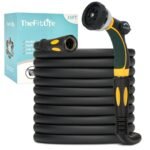Introduction to What Is a Fly Fishing Streamer?
Picture this: you’re in the heart of Montana, surrounded by majestic mountains and crystal-clear streams. You’ve spent hours perfecting your casting technique, and now it’s time to introduce a new element into your fly fishing repertoire – the fly fishing streamer.
A fly fishing streamer is a type of artificial fly that imitates a baitfish or other small prey. Unlike traditional dry flies that sit on the water’s surface or nymphs that mimic underwater insects, streamers are designed to be fished below the surface.
They are typically larger in size with long, flowing materials that create lifelike movement in the water. This enticing action attracts predatory fish, such as trout, bass, or pike, triggering their instinct to strike.
The Purpose and Design of Fly Fishing Streamers
You may be wondering, what’s the purpose and design of fly fishing streamers? Well, let me tell you!
Streamers are a type of fly used in fly fishing that imitates baitfish or other small aquatic creatures. They’re typically larger and heavier than other types of flies, which allows them to be cast further and reach deeper water.
The purpose of using streamers is to attract and entice predatory fish, such as trout, bass, or pike, to strike.
Streamers are designed to mimic the movement and appearance of their natural prey. They’re often tied using materials like feathers, fur, or synthetic fibers to create a lifelike imitation.
The colors and patterns of the streamer can vary depending on the type of fish being targeted and the conditions of the water.
Read More OutdoorGoodness Articles
Different streamer retrieval techniques can be used to simulate the erratic movements of injured or fleeing baitfish, which can trigger a predatory response from the fish.
By incorporating these streamer fly tying techniques and retrieval methods, anglers can increase their chances of enticing a strike from their target species.
So now that you understand the purpose and design of fly fishing streamers, let’s dive into how they can be used to target different species.
Targeting Different Species with Streamers
When targeting various species, using different types of streamers can effectively entice bites. Streamer fishing techniques offer a versatile approach that allows anglers to mimic baitfish or other prey items, provoking aggressive strikes from predatory fish.
By imitating the movement and appearance of injured or fleeing prey, streamers can trigger the predatory instincts of species like trout, bass, pike, and even saltwater fish.
The advantages of streamer fishing are numerous. Firstly, streamers can be fished at different depths, allowing anglers to target fish in both shallow and deep waters. Secondly, the action imparted to the streamer can be varied, making it possible to mimic different types of prey behavior.
Lastly, streamers are suitable for both stillwater and moving water environments, making them a versatile tool for anglers.
Transitioning into the subsequent section about techniques for fishing with streamers, it’s important to understand that streamer fishing requires specific techniques to maximize success.
Techniques for Fishing with Streamers
One effective way to entice predatory fish is by utilizing a variety of techniques while using streamers, allowing anglers to mimic the behavior of injured or fleeing prey.
When it comes to streamer retrieval techniques, there are several options to consider. One popular technique is the strip-and-pause method, where the angler strips the line in short, quick motions and then pauses momentarily before repeating. This imitates the erratic movement of injured prey and often triggers aggressive strikes from predatory fish.
Another technique is the swing method, where the angler casts the streamer across the current and allows it to swing downstream. This can be particularly effective when targeting fish that are holding in slower-moving water or near structure.
Lastly, the jerk-strip retrieve involves giving the line a quick jerk followed by a pause, mimicking the behavior of a fleeing prey. This technique can be especially effective when fishing in faster currents or when targeting larger, more aggressive fish.
When it comes to choosing the right streamer for the job, the color and pattern can play a crucial role in attracting fish. While personal preference and local conditions can influence the choice, there are a few general guidelines to consider.
Brightly colored streamers, such as chartreuse or orange, can be effective in murky or stained water, as they stand out and create a visual target for fish. On the other hand, natural colors like brown or olive can be more effective in clear water, where a more subtle presentation is needed.
Additionally, the pattern of the streamer can also make a difference. Streamers with a lot of movement, such as those with marabou feathers or rubber legs, can be enticing to fish as they imitate the motion of live prey.
Ultimately, experimenting with different colors and patterns is key to finding what works best in your fishing area. With these streamer retrieval techniques and knowledge of the best streamer colors and patterns, anglers can maximize their chances of success on the water.
Now, let’s dive into choosing the right streamer for the job and explore the different options available.
Choosing the Right Streamer for the Job
To find the perfect streamer for your angling adventure, it’s like searching for a brush stroke in an artist’s palette. Each color and pattern offers a unique allure to the fish below.
Streamer color selection plays a crucial role in enticing predatory fish to strike. Bright colors like chartreuse, white, and yellow are excellent choices for murky or stained water. They stand out and grab the attention of fish.
On the other hand, natural and earth-toned colors such as olive, brown, and black are ideal for clear water conditions. They mimic the appearance of baitfish or crayfish.
It’s essential to consider the water clarity and adjust your streamer color accordingly to increase your chances of success.
In addition to color, streamer size and weight considerations are also important factors in streamer selection. Larger streamers are effective for targeting larger fish. They mimic the profile of bigger prey and trigger an aggressive response.
However, it’s crucial to match the size of your streamer to the size of the fish you’re targeting. If the streamer is too large, it may intimidate smaller fish and deter them from striking.
Similarly, the weight of the streamer affects its action in the water. Heavier streamers sink faster and can be effective for deeper or faster-moving water. On the other hand, lighter streamers are better suited for shallower or slower-moving water.
By carefully considering the size and weight of your streamer, you can maximize its effectiveness and increase your chances of hooking into a trophy fish.
With the right streamer in hand, you’re now ready to learn some tips and tricks for successful streamer fishing.
Tips and Tricks for Successful Streamer Fishing
Mastering the art of streamer angling requires finesse and a keen understanding of the underwater world. When it comes to streamer fishing, the key lies in the streamer retrieval and presentation. The way you retrieve the streamer can make a significant difference in your success.
One technique is the strip retrieve, where you use short, quick strips to imitate a wounded baitfish. This can trigger predatory instincts in fish and entice them to strike.
Another technique is the swing retrieve, where you cast the streamer across the current and let it swing in the water. This mimics the movement of a fish swimming downstream and can be particularly effective in slower-moving waters.
Experimenting with different retrieves can help you find what works best for the specific conditions and the fish you are targeting.
In addition to the retrieval, the presentation of the streamer is equally important. You want to present the streamer in a way that looks natural and enticing to the fish.
One effective technique is to cast the streamer upstream and let it drift downstream with the current. This imitates the movement of a baitfish being carried by the current, and can be particularly effective in rivers and streams.
Another technique is to cast the streamer near structure, such as rocks or fallen trees, and let it swim along the edges. This can attract fish that are hiding in these areas and increase your chances of a strike.
It’s important to vary your presentation and experiment with different techniques to see what works best on any given day. By mastering the art of streamer retrieval and presentation, you can increase your chances of success and have a thrilling and rewarding fly fishing experience.
Frequently Asked Questions
Are streamers only used for fly fishing in rivers, or can they also be effective in lakes and ponds?
Streamers are not only used for fly fishing in rivers, they can also be effective in lakes and ponds. I love using streamers for ice fishing and bass fishing, as they mimic baitfish and entice strikes from hungry fish.
Can I use a streamer to catch smaller fish, or are they primarily designed for targeting larger species?
I can definitely use a streamer to catch smaller fish like panfish. When fishing with streamers, I employ various techniques to navigate fast moving currents, ensuring an exciting and rewarding experience.
How do I know when to use a sinking line versus a floating line when fishing with streamers?
When to use a sinking line versus a floating line when fishing with streamers depends on the depth and speed of the water. Choosing the right size and weight of streamer for different conditions is crucial for success.
Are there any specific colors or patterns of streamers that are more effective for certain types of fish?
For certain types of fish, specific colors and patterns work best when using streamers. Some recommendations include using bright colors for trout and natural patterns for bass. To effectively entice strikes, vary your presentation and retrieve speed.
Can streamers be used effectively in saltwater fly fishing, or are they primarily designed for freshwater fishing?
Streamers can be used effectively in both saltwater and freshwater fly fishing. While saltwater fishing presents its own set of challenges, the versatility of streamers allows for effective use in different environments, making them a valuable tool for anglers seeking freedom on the water.
Conclusion
As I reflect on the world of fly fishing streamers, I can’t help but chuckle at the irony of it all. Who’d have thought that a simple piece of feather and thread could hold such power over fish?
But here we are, with anglers around the globe swearing by the effectiveness of these deceptive little flies. It’s almost comical how something so artificial can mimic the movements of a real baitfish and entice even the wariest of trout.
And yet, it works. It’s as if the fish can’t resist the temptation, despite the fact that they’ve evolved for centuries to avoid predators. Oh, the irony!
But hey, I’m not complaining. If it means I can hook into some feisty rainbows or browns, then I’ll gladly play along with this little charade.
So next time you find yourself on the banks of a river, contemplating which fly to tie on, don’t overlook the power of a streamer. Embrace the irony and give it a try. You might just find yourself in the midst of an adrenaline-pumping battle with a trophy fish, all thanks to a tiny little feathered imposter.
And remember, in the world of fly fishing, nothing’s as it seems.

Meet Kevin Goodell, your outdoor adventure coach! With a passion for nature ignited in childhood, Kevin brings a wealth of experience and expertise to simplify tough outdoor skills. As a U.S. Army veteran and former Sergeant, he has honed his leadership and teamwork abilities while developing a deep love for the great outdoors.
Kevin’s dedication to outdoor activities spans biking, birdwatching, national park trips, and archery/golf. With his friendly and approachable demeanor, he is committed to guiding individuals of all ages and skill levels towards unforgettable outdoor experiences.
Harnessing his extensive knowledge and personal achievements, Kevin is your go-to resource for learning and enjoying various outdoor pursuits. Whether you seek thrilling adventures or serene nature escapes, Kevin’s professional yet friendly approach will ensure an engaging and informative experience. Embark on your next outdoor adventure with Kevin Goodell and embrace the beauty of nature like never before.






